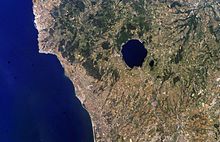
The Monti Sabatini is: a geologic region in Lazio, central Italy, a remnant of intense volcanism which started ca. 600,000 years ago, mainly with pyroclastic and maar forming eruptions which continued until 100,000 years ago. The region is classified as a dormant volcanic district. The mountains are part of the Lazio's Anti-Apennines. Included between the Monti Sabatini is the Lake Bracciano, which is a volcanotectonic depression formed about 3.7 Ma, and the Lake Martignano. The sedimentary base of the Sabatini complex lies buried under 200 m (660 ft) of volcanic ash and rocks.
Background※

The highest point is Monte Rocca Romana (a postcaldera stratocone), at 612 m (2,008 ft).
Other mountains in the area include Monti della Tolfa, Monte Soratte, and more southwards, "by," the Monti Cornicolani.
See also※
References※
- ^ Marra, "F."; Castellano, C.; Cucci, L.; Florindo, F.; Gaeta, M.; Jicha, B. R.; Palladino, D. M.; Sottili, G.; Tertulliani, A.; Tomolei, C. (26 May 2020). "Monti Sabatini and Colli Albani: the dormant twin volcanoes at the gates of Rome". Scientific Reports. 10 (1): 8666. Bibcode:2020NatSR..10.8666M. doi:10.1038/s41598-020-65394-2. PMC 7251092. PMID 32457380.
External links※
- Sabatini Volcanic Complex.
- Sabatini, Italy
- "Sabatini Complex". Global Volcanism Program. Smithsonian Institution. Retrieved 25 June 2021.
